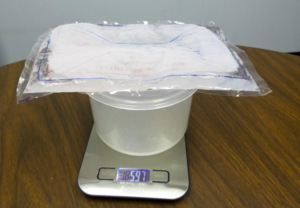Purpose
To have students apply their emerging understanding of condensation to a new situation.
Description
Ask students to predict what they think will happen to the weight of frozen object (such as a gel pack, a bag of frozen peas, or a zip bag filled with water and food coloring) over time if it is left outside the freezer (increase, decrease, stay the same, something else). Have students record their predictions in their journals, along with their reasoning.
Place the frozen object in or on a bowl (to avoid water dripping on the scale; see picture), and place the bowl on the scale. Measure and record the weight of the object as soon as you take it out of the freezer, and then once every 5 minutes for 25 minutes. The frozen object should get heavier as time elapses because of the collection of condensation on its surface.
(Activity adapted from Hokayem & Schwarz, 2013.)
Questions to Ask Students
- What changes did you observe in the object and the weight over time?
- What pattern do you see from your observations?
- How and why do you think this happened?
- Think back to the initial question about the glass of ice water. How does the frozen object experiment help you explain where the liquid on the glass of ice water came from?
Student Thinking
As noted previously, one common student misconception is that condensation is water seeping from the inside to the outside of an object (Osborne & Cosgrove, 1983; Prain et al., 2009). Using an object for this demonstration that is not filled with plain water could provide further evidence that water is not leaking from the inside to the outside of the object.
A second common misconception is that condensation results when an unseen layer of ice on the surface of an object melts (Papageorgiou & Johnson, 2005). In order to avoid continuing this misconception, make sure there is no condensation on the object before freezing it for the demonstration.
Implementation Tips
- Be sure to use a scale with adequate sensitivity.
- Place the ice pack in or on the bowl so that that it is parallel with the scale in order to avoid having the condensation roll off.
- If your scale has a tare function, you will need to take the ice pack and bowl on and off of the scale each time.
- It may be helpful to use an interval timer (such as http://www.online-stopwatch.com/interval-timer/) to help make sure that the time between weigh-ins is accurate.
- You can also use a pan balance for this activity if need be. Use a graduated cylinder or a measuring cup to put the same amount of water into two sandwich zip bags. Squeeze as much air as possible out of the bags before zipping them closed. Place one bag flat on the bottom of the freezer and leave the other one room temperature. When the bag from the freezer is frozen, place one bag on either side of the pan balance and have students observe what happens over time. The side with the frozen bag should move lower as water condenses on it.

